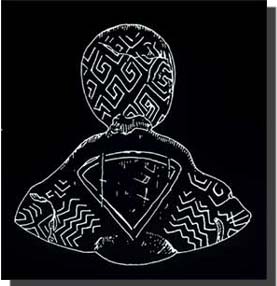

ALTHOUGH
THE SCRIPT TENDS TO MAKE THE ROOT-SIGNS MORE COMPLEX AND TO SHOW THEM
IN A MULTIPLE FORM, IT DOES NOT ENABLE THE LATTER TO BE DISMEMBERED OR
SIMPLIFIED INTO THEIR ELEMENTARY COMPONENTS. THE VARIOUS ROOT-SIGNS IN
THEIR COMPLETE VERSIONS (V, M, X…) HAVE COME STRAIGHT DOWN TO US
FROM PALAEOLITHIC TIMES.
In
this statuette of a female in the form of a bird from Mezin (Ukraine)
we can see meanders coupled with zigzags, multiple Vs, Ms and triangles.
The pattern of abstract signs that covers it is too complex and closely
interlinked to costitute a simple decoration.(Merlini
2002a)
Alexander Marshack (1992) suggests interpreting the signs as a structured system of symbols representing water, sky, time, earth and snakes. He reads abstract figurations of water, the sequence of time (seasons, lunar cycles…) and, at the same time, attributes or aspects of a female divinity or myths linked to her. Rather than a decoration, these stylised signs would indicate therefore a form of proto-script for conveying Paleolithic knowledge on the creation of life and fertility. The Mezin statuette is 17-20,000 years old.
Alexander Marshack (1992) suggests interpreting the signs as a structured system of symbols representing water, sky, time, earth and snakes. He reads abstract figurations of water, the sequence of time (seasons, lunar cycles…) and, at the same time, attributes or aspects of a female divinity or myths linked to her. Rather than a decoration, these stylised signs would indicate therefore a form of proto-script for conveying Paleolithic knowledge on the creation of life and fertility. The Mezin statuette is 17-20,000 years old.
Although
the root-signs can be multiplied and made more
complex with the addition of simple geometric patterns,
they cannot be broken down and simplified to arrive at their elementary
constituents.
Thus writing developed by means of the addition, and not by the subtraction, of graphic markers from the root-signs.
